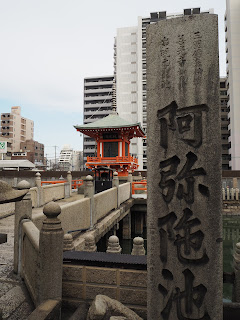Osaka 33 Kannon Pilgrimage in My Order (6)
I visited Wako-ji Temple to look for the site of #31 Daifuku-in Temple, with the idea that Daifuku-in might have been a branch temple or a hall of Wako-ji Temple. I took Nankai Shiomibashi Line for the first time in my life. It has 2 services an hour, and each service has only 2 cars. In the midst of the third biggest city in Japan, it seems more like a provincial line. I walked north from the terminal, Shiomibashi Station, crossed Shiomi-bashi Rridge across Dotonbori River. After the Shiomi-bashi Bridge, there used to be a Shiraga-bashi Bridge across Nishi-Nagahori River. Wako-ji Temple was just before the bridge.
In the Edo Period, the precincts of Wako-ji Temple had the main hall, Hoko-kaku Hall, Fumon-do Hall, Aizen-do Hall, Takushi-do Hall, Makko-Jizo-do Hall, Enma-do Hall, Jizo-do Hall, Kompira-Gongen Shrine, Kondo-Jizo Hall, and a bell tower as well as Kannon-do Hall. The temple held lotteries and garden markets of plants, and offered part of its precincts as theaters for Joruri (a narrative ballad chanted to the accompaniment of shamisen), Koshaku (Japanese storytelling), and Karuwaza (acrobatics). The precincts also had souvenir shops. Outside the precincts, there were 47 brothels. As "iroha", the Japanese syllabary, consisted of 47 characters, the redlight district was called Iroha Brothels. An old guidebook said, "Daifuku-in Temple is located in the north of Amida-ike Pond and in the west of brothels."
Organizers of any 33 Kannon pilgrimages tended to include popular temples to increase the number of their pilgrims.
Why was Wako-ji Temple so popular? It had Amida-ike Pond, from which the Amitabha image which is enshrined in Zenko-ji Temple in Nagano Prefecture was salvaged.
The #31 temple's name Daifuku-in is, strangely enough, the same with the ingo of #30 Mitsu-tera Temple. The organizer of the Osaka 33 Kannon Pilgrimage might have picked up a nameless hall as its #31 and given the ingo of #30 as its name.
The first Bombing of Osaka took place from the middle of the night on March 13, 1945, to the early morning of the next day. All the temple buildings of Wako-ji Temple were reduced to ashes. It is unknown when and why Enkho-ji Temple was abolished. Its eleven-faced Ekadasamukha statue? Nobody knows.
The western edge of Wako-ji Temple could have been a seashore, where the ships from Silla landed. From one of those Sills ships, Mononobe Okoshi and Nakatomi Kamako might have thrown the Amitabha image into Amide-ike Pond in 552. When Honda Yoshimitsu visited Naniwa from 600 to 602, he found the image and brought it back to his hometown, Shinano Province.
I walked along the western edge of Wako-ji Temple. The busy street had nothing left of what the seashore used to have or what the incident there looked like.
Wako-ji TempleAddress: 3 Chome-7-27 Kitahorie, Nishi Ward, Osaka, 550-0014
Phone: 06-6531-1360
After the visit to Wako-ji Temple, I walked around in the north of the temple. There was only a parking area.





















0 Comments:
Post a Comment
<< Home